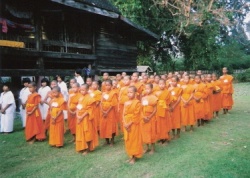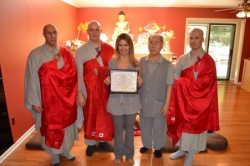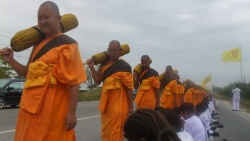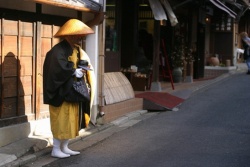Difference between revisions of "Colors and Types of Robes"
(Created page with "thumb|250px| <poem> The clothing worn by Buddhist monks and priests varies greatly, from the simple saffron robes of the monks of Thailand an...") |
|||
| (One intermediate revision by the same user not shown) | |||
| Line 1: | Line 1: | ||
[[File:Ding.jpg|thumb|250px|]] | [[File:Ding.jpg|thumb|250px|]] | ||
| + | |||
| + | |||
| + | |||
| + | |||
| + | |||
| + | |||
<poem> | <poem> | ||
| − | The clothing worn by [[Buddhist]] [[monks]] and priests varies greatly, from the simple saffron robes of the [[monks]] of [[Thailand]] and [[Sri Lanka]] to the highly elaborate robes and headdresses of the {{Wiki|Tibetan}} [[lamas]]. But they all share a similar origin and basic idea, making them recognizable as [[Buddhist]] [[monastic robes]]. | + | The clothing worn by [[Buddhist]] [[monks]] and {{Wiki|priests}} varies greatly, from the simple {{Wiki|saffron}} [[robes]] of the [[monks]] of [[Thailand]] and [[Sri Lanka]] to the highly elaborate [[robes]] and headdresses of the {{Wiki|Tibetan}} [[lamas]]. But they all share a similar origin and basic [[idea]], making them recognizable as [[Buddhist]] [[monastic robes]]. |
| − | he historical [[Buddha]] is said to have worn a [[ | + | he historical [[Buddha]] is said to have worn a {{Wiki|humble}} [[monk]]'s robe made of patched pieces of donated cloth throughout his [[life]]. He is depicted in painting and {{Wiki|sculpture}} with such a robe draped over his [[body]], often leaving his right shoulder bare. |
| − | Similarly, the monks of the [[Theravada]] [[tradition]] of [[Sri Lanka]], [[Cambodia]], and [[Thailand]] wear plain saffron or ochre robes. This reddish-yellow color is called [[kasaya]] or [[kasava]] in [[Pali]] sources and [[kashaya]] in [[Sanskrit]] sources. These [[monks]] wear these simple robes in emulation of the [[Buddha]]'s humble garb and to represent their own {{Wiki|detachment}} from the physical [[world]] in their pursuit of [[enlightenment]]. | + | Similarly, the [[monks]] of the [[Theravada]] [[tradition]] of [[Sri Lanka]], [[Cambodia]], and [[Thailand]] wear plain {{Wiki|saffron}} or ochre [[robes]]. This reddish-yellow {{Wiki|color}} is called [[kasaya]] or [[kasava]] in [[Pali]] sources and [[kashaya]] in [[Sanskrit]] sources. These [[monks]] wear these simple [[robes]] in emulation of the [[Buddha]]'s [[humble]] garb and to represent their [[own]] {{Wiki|detachment}} from the [[physical]] [[world]] in their pursuit of [[enlightenment]]. |
| − | The robes of [[Mahayana]] (Northern) [[Buddhist]] [[monks]], on the other hand, varies considerably, due mainly to geography and climate. In paintings, the founders of many East Asian [[Buddhist]] sects are commonly depicted wearing beautifully embroidered and brocaded silk robes. However, the [[monks]] of many of the schools of {{Wiki|China}}, {{Wiki|Korea}} and {{Wiki|Japan}} generally wear more {{Wiki|austere}} robes, with a simple cloth collar suspended around their necks. | + | The [[robes]] of [[Mahayana]] ([[Northern]]) [[Buddhist]] [[monks]], on the other hand, varies considerably, due mainly to {{Wiki|geography}} and climate. In paintings, the founders of many {{Wiki|East Asian}} [[Buddhist]] sects are commonly depicted wearing beautifully embroidered and brocaded {{Wiki|silk}} [[robes]]. However, the [[monks]] of many of the schools of {{Wiki|China}}, {{Wiki|Korea}} and {{Wiki|Japan}} generally wear more {{Wiki|austere}} [[robes]], with a simple cloth collar suspended around their necks. |
[[File:DSC 0297.JPG|thumb|250px|]] | [[File:DSC 0297.JPG|thumb|250px|]] | ||
| − | {{Wiki|Chinese}} and {{Wiki|Korean}} [[monks]] wear brown, grey or blue; {{Wiki|Japanese}} [[monks]] wear black or grey robes. In {{Wiki|Japan}}, a type of prayer robe known as a [[kesa]] is worn over the regular robes. [[Kesa]] are usually patched together with scraps of fine silk brocade in imitation of the [[Buddha]]'s patchwork robes. Like those of a [[mandala]], the geometric patterns are said to {{Wiki|symbolize}} the {{Wiki|universe}}. | + | {{Wiki|Chinese}} and {{Wiki|Korean}} [[monks]] wear brown, grey or blue; {{Wiki|Japanese}} [[monks]] wear black or grey [[robes]]. In {{Wiki|Japan}}, a type of [[prayer]] robe known as a [[kesa]] is worn over the regular [[robes]]. [[Kesa]] are usually patched together with scraps of fine {{Wiki|silk}} brocade in imitation of the [[Buddha]]'s patchwork [[robes]]. Like those of a [[mandala]], the geometric patterns are said to {{Wiki|symbolize}} the {{Wiki|universe}}. |
| − | The most elaborate [[Buddhist]] robes are found in {{Wiki|Tibet}} and throughout the {{Wiki|Himalayas}}, in the {{Wiki|esoteric}} form of [[Buddhism]] known as [[Vajrayana]]. Like {{Wiki|Tibetan}} [[Buddhist]] {{Wiki|art}}, {{Wiki|Tibetan}} [[Buddhist]] robes tend to be very colorful. | + | The most elaborate [[Buddhist]] [[robes]] are found in {{Wiki|Tibet}} and throughout the {{Wiki|Himalayas}}, in the {{Wiki|esoteric}} [[form]] of [[Buddhism]] known as [[Vajrayana]]. Like {{Wiki|Tibetan}} [[Buddhist]] {{Wiki|art}}, {{Wiki|Tibetan}} [[Buddhist]] [[robes]] tend to be very colorful. |
| − | The colors vary according to the particular sect: [[monks]] of the [[Gelukpa]] order, for example, to which the [[Dalai Lama]] belongs, wear yellow pointed hats. | + | The colors vary according to the particular [[sect]]: [[monks]] of the [[Gelukpa]] order, for example, to which the [[Dalai Lama]] belongs, wear [[yellow]] pointed hats. |
During certain [[Vajrayana]] [[Buddhist]] {{Wiki|ceremonies}}, such as {{Wiki|exorcisms}}, [[lamas]] wear large helmet-like headdresses with crescent-shaped peaks. | During certain [[Vajrayana]] [[Buddhist]] {{Wiki|ceremonies}}, such as {{Wiki|exorcisms}}, [[lamas]] wear large helmet-like headdresses with crescent-shaped peaks. | ||
[[File:DSCF0365.jpg|thumb|250px|]] | [[File:DSCF0365.jpg|thumb|250px|]] | ||
| − | In other [[rituals]], such as {{Wiki|initiation}} {{Wiki|ceremonies}}, lamas wear {{Wiki|crowns}} with five sections, each containing one of the [[Five Dhyani Buddhas]] or the [[Sanskrit]] syllables that represent their essence. While wearing such a crown, the monk or priest summons up a particular deity, who may be depicted in painting wearing a similar five-part {{Wiki|crown}}. | + | In other [[rituals]], such as {{Wiki|initiation}} {{Wiki|ceremonies}}, [[lamas]] wear {{Wiki|crowns}} with [[five sections]], each containing one of the [[Five Dhyani Buddhas]] or the [[Sanskrit]] {{Wiki|syllables}} that represent their [[essence]]. While wearing such a {{Wiki|crown}}, the [[monk]] or [[priest]] summons up a particular [[deity]], who may be depicted in painting wearing a similar five-part {{Wiki|crown}}. |
Uses and Practices | Uses and Practices | ||
[[File:Eggs.jpg|thumb|250px|]] | [[File:Eggs.jpg|thumb|250px|]] | ||
| − | The [[Sanskrit]] and [[Pali]] word for [[monastic robes]] is [[civara]]. Wearing [[civara]] is the first of a [[monk]]'s four traditional requirements ([[nisraya]]). [[Monks]] are instructed never to enter a village without wearing all three parts of their robe: | + | The [[Sanskrit]] and [[Pali]] [[word]] for [[monastic robes]] is [[civara]]. Wearing [[civara]] is the first of a [[monk]]'s four [[traditional]] requirements ([[nisraya]]). [[Monks]] are instructed never to enter a village without wearing all three parts of their robe: |
an [[inner robe]], from the waist to the knee | an [[inner robe]], from the waist to the knee | ||
| Line 26: | Line 32: | ||
an [[outer robe]] used as an [[overgarment]] | an [[outer robe]] used as an [[overgarment]] | ||
| − | Material for new robes is traditionally donated by laypersons in the [[kathina]] {{Wiki|ceremony}}, which occurs across Southeast Asia after the rainy season. This is one of the few {{Wiki|monastic}} {{Wiki|ceremonies}} that involves the laity, and it helps them to gain [[merit]]. | + | Material for new [[robes]] is [[traditionally]] donated by laypersons in the [[kathina]] {{Wiki|ceremony}}, which occurs across {{Wiki|Southeast Asia}} after the [[rainy season]]. This is one of the few {{Wiki|monastic}} {{Wiki|ceremonies}} that involves the laity, and it helps them to gain [[merit]]. |
| − | There are a number of ways the [[monks]] wear their robes, depending on their sect and country. The most universal one is that which is worn for the alms-round, when the robe is covering both the shoulders. | + | There are a number of ways the [[monks]] wear their [[robes]], depending on their [[sect]] and country. The most [[universal]] one is that which is worn for the [[alms-round]], when the robe is covering both the shoulders. |
| − | Within the [[monastery]] or {{Wiki|residence}} or when having an {{Wiki|audience}} with a more senior monk, a simpler style is adopted, as a gesture of respect and to facilitate work. The right side of the robe is pushed under the armpit and over the robe on the left leaving the right shoulder bare. | + | Within the [[monastery]] or {{Wiki|residence}} or when having an {{Wiki|audience}} with a more [[senior monk]], a simpler style is adopted, as a gesture of [[respect]] and to facilitate work. The right side of the robe is pushed under the armpit and over the robe on the left leaving the right shoulder bare. |
The [[Buddhist]] [[monastic robe]] is so versatile that it can be used, besides what is already mentioned, as a blanket, a seat-spread, a groundsheet, a head-cover, a windbreaker, etc. It is easy to clean and repair. It is perhaps the oldest style of dress still in fashion after 2,500 years. | The [[Buddhist]] [[monastic robe]] is so versatile that it can be used, besides what is already mentioned, as a blanket, a seat-spread, a groundsheet, a head-cover, a windbreaker, etc. It is easy to clean and repair. It is perhaps the oldest style of dress still in fashion after 2,500 years. | ||
Sources | Sources | ||
| − | Meher McArthur, Reading Buddhist Art: An Illustrated Guide to Buddhist Signs and Symbols (Thames & Hudson, 2004), 155. | + | Meher McArthur, Reading [[Buddhist Art]]: An Illustrated Guide to [[Buddhist]] [[Signs]] and [[Symbols]] (Thames & Hudson, 2004), 155. |
| − | "civara." Damien Keown, Oxford Dictionary of Buddhism (2004). | + | "[[civara]]." [[Damien Keown]], {{Wiki|Oxford}} {{Wiki|Dictionary}} of [[Buddhism]] (2004). |
| − | "The Monastic Robes." Buddhanet.net | + | "The [[Monastic Robes]]." Buddhanet.net |
</poem> | </poem> | ||
{{R}} | {{R}} | ||
[http://www.religionfacts.com/buddhism/things/monks_robes_hats.htm www.religionfacts.com] | [http://www.religionfacts.com/buddhism/things/monks_robes_hats.htm www.religionfacts.com] | ||
[[Category:Monastic robes]] | [[Category:Monastic robes]] | ||
Latest revision as of 06:09, 27 February 2016
The clothing worn by Buddhist monks and priests varies greatly, from the simple saffron robes of the monks of Thailand and Sri Lanka to the highly elaborate robes and headdresses of the Tibetan lamas. But they all share a similar origin and basic idea, making them recognizable as Buddhist monastic robes.
he historical Buddha is said to have worn a humble monk's robe made of patched pieces of donated cloth throughout his life. He is depicted in painting and sculpture with such a robe draped over his body, often leaving his right shoulder bare.
Similarly, the monks of the Theravada tradition of Sri Lanka, Cambodia, and Thailand wear plain saffron or ochre robes. This reddish-yellow color is called kasaya or kasava in Pali sources and kashaya in Sanskrit sources. These monks wear these simple robes in emulation of the Buddha's humble garb and to represent their own detachment from the physical world in their pursuit of enlightenment.
The robes of Mahayana (Northern) Buddhist monks, on the other hand, varies considerably, due mainly to geography and climate. In paintings, the founders of many East Asian Buddhist sects are commonly depicted wearing beautifully embroidered and brocaded silk robes. However, the monks of many of the schools of China, Korea and Japan generally wear more austere robes, with a simple cloth collar suspended around their necks.
Chinese and Korean monks wear brown, grey or blue; Japanese monks wear black or grey robes. In Japan, a type of prayer robe known as a kesa is worn over the regular robes. Kesa are usually patched together with scraps of fine silk brocade in imitation of the Buddha's patchwork robes. Like those of a mandala, the geometric patterns are said to symbolize the universe.
The most elaborate Buddhist robes are found in Tibet and throughout the Himalayas, in the esoteric form of Buddhism known as Vajrayana. Like Tibetan Buddhist art, Tibetan Buddhist robes tend to be very colorful.
The colors vary according to the particular sect: monks of the Gelukpa order, for example, to which the Dalai Lama belongs, wear yellow pointed hats.
During certain Vajrayana Buddhist ceremonies, such as exorcisms, lamas wear large helmet-like headdresses with crescent-shaped peaks.
In other rituals, such as initiation ceremonies, lamas wear crowns with five sections, each containing one of the Five Dhyani Buddhas or the Sanskrit syllables that represent their essence. While wearing such a crown, the monk or priest summons up a particular deity, who may be depicted in painting wearing a similar five-part crown.
Uses and Practices
The Sanskrit and Pali word for monastic robes is civara. Wearing civara is the first of a monk's four traditional requirements (nisraya). Monks are instructed never to enter a village without wearing all three parts of their robe:
an inner robe, from the waist to the knee
an upper robe, around the torso and shoulders
an outer robe used as an overgarment
Material for new robes is traditionally donated by laypersons in the kathina ceremony, which occurs across Southeast Asia after the rainy season. This is one of the few monastic ceremonies that involves the laity, and it helps them to gain merit.
There are a number of ways the monks wear their robes, depending on their sect and country. The most universal one is that which is worn for the alms-round, when the robe is covering both the shoulders.
Within the monastery or residence or when having an audience with a more senior monk, a simpler style is adopted, as a gesture of respect and to facilitate work. The right side of the robe is pushed under the armpit and over the robe on the left leaving the right shoulder bare.
The Buddhist monastic robe is so versatile that it can be used, besides what is already mentioned, as a blanket, a seat-spread, a groundsheet, a head-cover, a windbreaker, etc. It is easy to clean and repair. It is perhaps the oldest style of dress still in fashion after 2,500 years.
Sources
Meher McArthur, Reading Buddhist Art: An Illustrated Guide to Buddhist Signs and Symbols (Thames & Hudson, 2004), 155.
"civara." Damien Keown, Oxford Dictionary of Buddhism (2004).
"The Monastic Robes." Buddhanet.net



